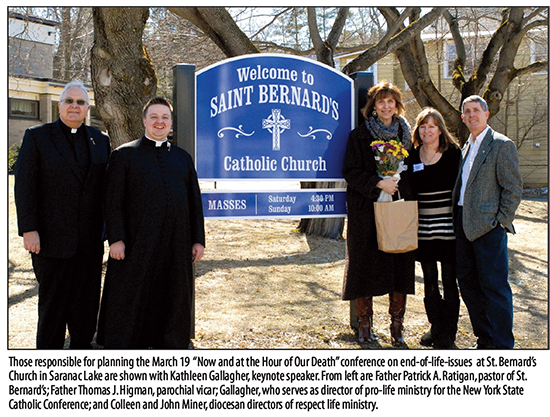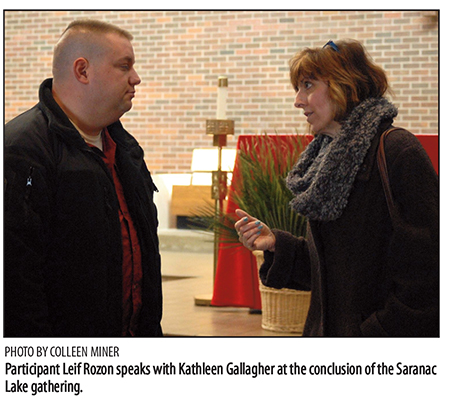March 30, 2016 By Colleen Miner Saranac Lake – The 50 participants of the March 19 end-of-life conference at St. Bernard’s Church heard Kathleen Gallagher of the New York State Catholic Conference say “we must provide aid in living, not aid in dying.” Gallagher, director of pro-life activities for the conference, was the keynote speaker at the program titled “Now and At the Hour of Our Death,” also the name of the New York State bishops’ guide to end-of-life decision making. The priests of St. Bernard’s Father Patrick Ratigan, pastor; and Father Thomas Higman, parochial vicar, opened the program. Father Higman pointed out that the word "compassion" in Latin, means “co-suffering” and noted the appropriateness of the conference being held on the Feast of St. Joseph, the Patron Saint of a Happy Death. The “Patient Self Determination Act” and the “End of Life Options Act” do not require psychiatric counseling for depression, lack safeguards, discriminate against people with disabilities and require that the death certificate list the cause of death as the illness, not suicide, she said. The patient-doctor relationship suffers because the legislation turns doctors into killers who do not uphold the Hippocratic Oath. In order to provide “aid in living, not aid in dying,” Gallagher said, “we must work to remove obstacles to hospice utilization, in which New York ranks 49th in the nation and must increase education in pain management and promote palliative care.” Participants heard about the composition of the legislature and the importance of contacting representatives to make opposition known. An easy way to stay informed and contact legislators, Gallagher said, is through the Catholic Action Network Gallagher discussed the two life and death personal stories of Brittany Maynard and JJ Hanson who both suffered from the same aggressive brain cancer. Britany moved to Oregon (one of five states with physician assisted suicide) to kill herself. In contrast, JJ heroically fought the cancer and is now in remission. “New York State sends first responders if someone is suicidal and spends millions of dollars to prevent suicide, yet this legislation sends the message that some suicides are acceptable,” Gallagher said. “It sends the message that some lives are not worth living.” The afternoon session addressed end-of-life decision making and the difference between allowing natural death to occur vs. hastening the moment of death. Ordinary and extraordinary treatments were discussed as well as the fact that each situation is different. “We must make good, prudential judgements based on whether treatment is beneficial or burdensome, asking whether the treatment is proportionate to the benefits,” Gallagher said. “All circumstances must be taken into account.”
When making decisions, she recommended that people pray, seek counsel from loved ones, and speak to medical professionals to gather information. Gallagher said that the bishops of the state recommend Catholics complete a health care proxy to name someone to make medical decisions for them if there comes a time when they cannot. “When choosing a proxy one should consider someone of good moral character who knows your value and beliefs who operates well under stress,” she said. “It’s important to plan ahead and have conversations with your proxy. Living Wills are legal, but not preferable, as they vest power in a piece of paper instead of a human person.” MOLST, Medical Orders for Life Sustaining Treatment, tries to combine all forms. MOLST was designed for those who have one year or less to live but can be dangerous if not used properly, Gallagher said. “Circumstances can change, advances occur in health care, changes in medical situations - this is why our bishops have urged great caution with regard to MOLST,” she said. The day ended with a question and answer period, followed by a Holy Hour with Eucharistic Adoration. |
||||

 which is accessed through the New York State Catholic Conference website
which is accessed through the New York State Catholic Conference website  Nutrition and hydration are considered normal, ordinary care in most circumstances, explained Gallagher, noting particular exceptions, and urging participants to reference the U.S. Bishops’ “Ethical and Religious Directives for Catholic Healthcare” or the Catechism of the Catholic Church when in doubt.
Nutrition and hydration are considered normal, ordinary care in most circumstances, explained Gallagher, noting particular exceptions, and urging participants to reference the U.S. Bishops’ “Ethical and Religious Directives for Catholic Healthcare” or the Catechism of the Catholic Church when in doubt. 